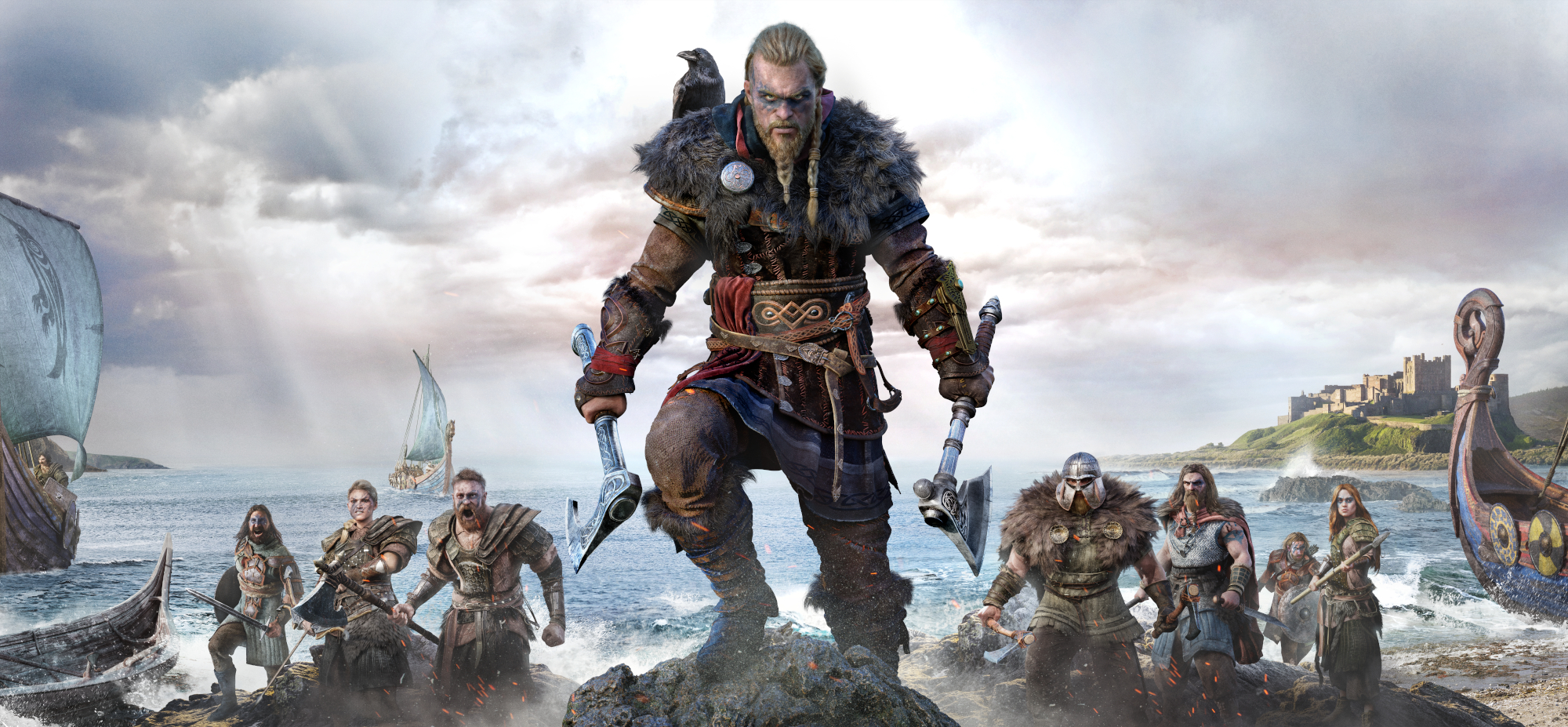There are a lot of Assassin’s Creed games. Since the early years of the Xbox 360 and PS3 life cycle, Ubisoft’s marquee action-stealth-RPG franchise has been one of the biggest blockbuster staples in the big-budget, triple-A gaming space. Since 2009’s Assassin’s Creed II in fact, Ubisoft has never failed to release an Assassin’s Creed game at some point within each year (if you include the remasters that filled the mainline sequels’ gap years, 2016 and 2018), and that can make it incredibly easy to fall behind on the series’ robust lineup of titles– Like I did. I always liked Assassin’s Creed in its genesis, even its more contested first entry from 2007. The thing is though, it was just one of those franchises that quickly got away from me. It’s been over a decade since I’ve played an Assassin’s Creed game in earnest, and yet despite that, I found myself previewing the upcoming Assassin’s Creed Valhalla, the newest mainline game set to keep expanding the series’ increasingly large library later this year.
Longtime Assassin’s Creed fans that have never failed to play each virtually annualized sequel through to completion would no doubt scoff at this prospect, and perhaps even fume about a rookie like me suddenly being handed the chance to play an upcoming game in a series that I’ve always wanted to catch up on, but just haven’t found the time to do so at this point. My initial hesitation to preview Assassin’s Creed Valhalla after such a lengthy absence from the franchise quickly melted away when I recalled a simple fact early in my play session though; Assassin’s Creed Valhalla isn’t just a new Assassin’s Creed game, it’s a launch title for a new generation of consoles. This means that when people are potentially planning to pick up a brand new PS5 and/or Xbox Series X towards the end of this year, they may feel that Assassin’s Creed Valhalla is the launch title that’s most appealing to them, and I guarantee that a good chunk of those people have little to no experience with the Assassin’s Creed franchise. You’ve got to buy at least one game to go with your shiny new next-gen console, right? Why not make it a sweeping epic about Viking warriors?
Thus, while the veteran’s perspective is certainly important, and necessary for those who have played every Assassin’s Creed game inside and out since 2007, it’s not the only perspective that matters. There’s no denying that plenty of rookies will be purchasing or receiving copies of Assassin’s Creed Valhalla for their PS5 or Xbox Series X during this coming Holiday season, and in some cases, no doubt the current-gen PS4 and Xbox One versions as well (though both Xbox builds helpfully come in one package, thanks to Smart Delivery!). So, maybe the rookie’s perspective on this anticipated sequel is equally valuable. There’s no doubt going to be plenty of fledgling players who will be just as confused and initially overwhelmed as I was, possibly trying to jump back into a series that has extensively evolved since the previous decade, and that’s assuming they’ve played any Assassin’s Creed game at all beforehand!
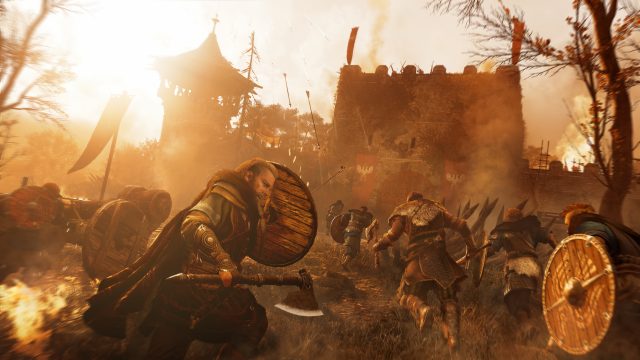
Whether you’re a rookie or a veteran however, there are some basic facts about this Assassin’s Creed sequel that are essential to know. This latest game in the series takes place in 873 AD, just the latest of numerous unique historical backdrops that have spanned each new mainline entry in the Assassin’s Creed series, including its 2016 movie adaptation. Players control a Viking raider, Eivor, who can be male or female, depending on the player’s preference. For reference, my Eivor in the preview build was male, which lent itself so well to an especially funny sexual encounter towards the end of my play session. Oh yes, character romances are back with a vengeance in Assassin’s Creed Valhalla! Anyway, Assassin’s Creed Valhalla is all about Eivor leading his/her Viking clan to settle new lands in England, naturally bringing him/her into conflict with various Anglo-Saxon kingdoms. One particular bugbear among these kingdoms during my preview session was East Anglia, a territory that’s initially none too happy about the presence of the, “Heathen” Vikings. That said, a bigger issue during my demo was a rival Viking clan, led by a not-so-nice fellow named Rued, who was my main quarry throughout the demo session, once I tracked him down in the game’s expansive open world.
This is where my long absence from the Assassin’s Creed series became very apparent. The massive, sprawling world of Assassin’s Creed Valhalla is so vast and packed with distractions that I completely failed to take notice of my first main objective, once I gained control of Eivor. I rode on horseback for a bit, talking to Eivor’s buddy, Finnr about how much of a problem Rued and his men have been for Eivor’s clan, and then, I just kind of rode on. The world was so inviting, and thanks to an ability to have your horse automatically follow the main road for as long as you please, while players can optionally employ a cinematic camera for the best view of their gorgeous surroundings, I found myself taken with it very quickly, even when my demo was capped at 1080p resolution and 30fps. That latter point should be unsurprising, since even Assassin’s Creed Valhalla’s next-gen PS5 and Xbox Series X versions will cap the performance at a very modest 30fps, a point of contention among many fans already. Even though I was playing a PC build of the game as well, exclusively with an Xbox One controller in this case, the specs were set at around the level of what one can expect on a base PS4 or Xbox One console. Assassin’s Creed Valhalla still looks great on even base, current-gen PS4/Xbox One console specs, but a lot of the planned bells and whistles in the next-gen console versions and PC version weren’t available to me during the demo, and that was a shame. Not that I fixated on that much during the rather intense combat especially.
Players will need to be extra vigilant with their health in Assassin’s Creed Valhalla, something that I routinely learned the hard way throughout the demo. This is because enemies can do a lot of damage to Eivor in a short amount of time, even on what’s presumably the default medium difficulty setting. Players can back step and dodge roll to evade enemy attacks, sure, but this consumes a stamina bar, something that does thankfully recharge quickly, as long as you don’t abuse it. Eivor’s health doesn’t regenerate on its own either, contrary to some prior games in the Assassin’s Creed series. Instead, players can restore Eivor’s health using either a limited number of ‘Rations’, which can be consumed with the tap of a button, or, more commonly, by consuming edible plants around the combat area. If this sounds an awful lot like Dark Souls combat, well, it’s very clearly inspired by Dark Souls combat, right down to how severely players can be punished for getting sloppy during battles! Compounding the importance of fighting strategically is the fact that Assassin’s Creed Valhalla is making an effort to restore some of the stealth mechanics that the series has somewhat moved away from in recent years, complete with Eivor being able to instantly dispatch unaware enemies, as well as hide from enemies by either feigning death, or, in true Assassin’s Creed fashion, jumping into a pile of hay.
As another consequence to this design direction, I was also informed that some of the RPG elements that have pervaded the Assassin’s Creed series’ recent prequel entries have been somewhat scaled back in Assassin’s Creed Valhalla, at least in terms of how Eivor’s skills develop. Players utilize a rather simple Skill Point system to activate nodes on a series of constellations within the upgrade map, which represent different combat disciplines, emphasizing methods such as stealth, precision and aggression, both in terms of upgrading Eivor’s base stats, and activating new manual skills for him/her. This allows players to craft Eivor’s combat aptitude however they see fit, but in truth, the greatest play flexibility often comes from the especially robust selection of equippable weapons and armour in Assassin’s Creed Valhalla.
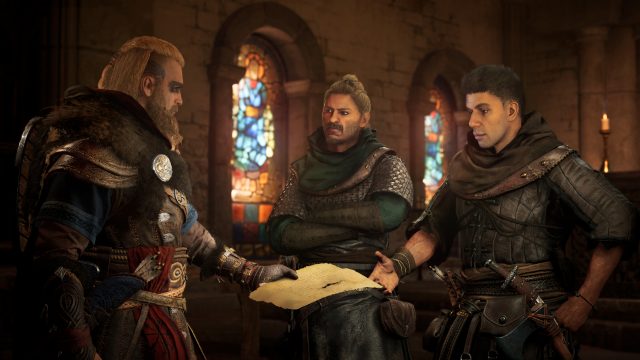
I most often relied on a well-rounded battle axe to kill enemies, but Assassin’s Creed Valhalla also supports weapons like great swords, flails, and of course, a handy bow and arrow that you can whip out with the left bumper, whenever you want to strike enemies at a distance. Most weapons in the game can now be dual wielded too, at the cost of leaving Eivor a bit more vulnerable to enemy arrows in particular, since this doesn’t allow him/her to utilize a shield. Of course, if you want to go all in on offense, you can also give Eivor a massive sword or axe that must be wielded with two hands, something that I did at one point later on, and while I was killed pretty quickly by the crowd of enemies around me, it was a lot of fun to heavily chop through a bunch of them before that happened. Apparently, the game will also allow you to equip two shields, if you fancy, though this is probably a less desirable play method for many that would prefer to make use of all-new weapon archetypes like flails, which are great for crowd control during raids especially.
The sheer amount of flexibility through which you can craft your arsenal and play style in Assassin’s Creed Valhalla is genuinely staggering for uninitiated players that just learned to grasp the concept of a hidden blade. In fact, the primitive weapons wielded by Altair and Ezio in the earliest Assassin’s Creed games feel rather quaint in contrast to the numerous combat options afforded to Eivor in Assassin’s Creed Valhalla, particularly when certain weapons and gear can be upgraded right from the gear menu, using crafting ingredients that you can collect during your travels. It can be a little overwhelming for someone like me at first, specifically someone who’s at least well-versed in RPG’s, but not the staggering levels of gameplay freedom that recent Assassin’s Creed games now offer players, freedom that’s also incredibly plentiful throughout Assassin’s Creed Valhalla! On the bright side however, there’s really no wrong way to play Assassin’s Creed Valhalla, in contrast to the older Assassin’s Creed games. Those older titles definitely favoured certain play methods over others, particularly with their pushing of ‘social stealth’, which, in fairness, does make a bit of a comeback in Assassin’s Creed Valhalla, considering the returns of the hood function to blend into crowds of NPC’s, and hiding spots like hay bales.
In any case, once I tired of poking around the open world, gathering loot and dispatching wolves, I eventually returned to a settlement, another classic Assassin’s Creed feature that’s set to make a return in Assassin’s Creed Valhalla, where they will serve as mission hubs. Settlements can supposedly be upgraded to provide passive bonuses to the player, on top of allowing you to forge military alliances through diplomatic marriages, likely granting you more troops for raids. In my demo session however, settlements merely served as the site where I activated story missions, so I wasn’t able to play test these planned features. I was able to talk to the settlement’s sheriff, or, “reeve” though, who complained about Rued, big surprise. The reeve didn’t seem to be Eivor’s biggest fan either, presenting me with some varied dialogue options, a returning feature from the previous Assassin’s Creed Odyssey. I did eventually talk the reeve into giving me a chance, thankfully, whereupon he asked me to take a nearby fort back from Rued’s men, and blow the giant horn at the top when I was successful. This was a mission I happily accepted, being eager to curry the reeve’s favour for an upcoming battle.
This is where a potential disappointment may pop up for some longtime fans of Assassin’s Creed– The naval combat that was so plentiful in many fan-favourite entries has been heavily downscaled, if not eliminated entirely in Assassin’s Creed Valhalla. In fact, in a somewhat embarrassing blunder, I didn’t even initially put together that there was an ability to travel with troops by water! I did eventually stumble onto a longboat full of allies though, after valiantly, but foolishly trying to liberate the reeve’s coveted fort by myself, a mission that routinely ended with me being overwhelmed and killed. Fortunately, once I sicced my longboat troops on the fort, I took it without much difficulty, blowing the horn to signal the reeve that I accomplished my mission. The reeve then made the trip to me from there, pledging his allegiance in an upcoming battle to save East Anglia from the ravages of Rued. Believe me, I would need every bit of his help!
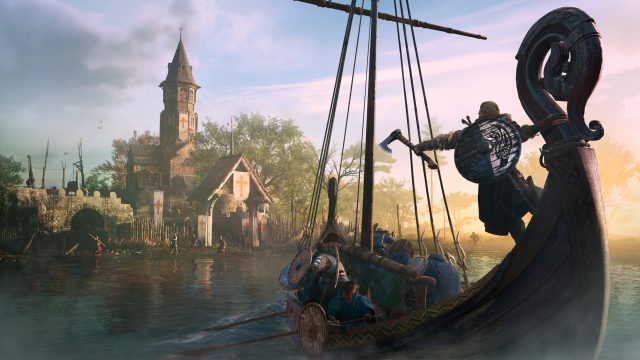
One rousing speech to the troops later, and I found myself riding hostile waters on the way to Burgh Castle, where Rued was waiting for Eivor’s newly-grown army. This is the closest that Assassin’s Creed Valhalla apparently comes to naval battles, purely putting me on the defensive, as I occasionally had to raise my shield to protect against barrages of flaming arrows. Once I hit shore however, a way into the rain-soaked castle burst open, and a bunch of my fellow soldiers picked up a battering ram, beginning to run it against the wooden barrier ahead. Eivor even has the option of joining the ramming effort, allowing my soldiers to get further into the castle more quickly, which is the core objective. While ramming however, Eivor is especially vulnerable to enemy attacks, so there were instances where it was more prudent for me to let my soldiers solely do the ramming instead, while I did my best to chop up Rued’s thugs, using a variety of different weapon options.
I won’t lie; This grand raid sequence saw me dying quite a bit. This battle is extremely chaotic, and represents the one instance where I was thankful to have a steady, unflinching 30fps framerate, considering all of the pandemonium around me on mid-range PC settings! I constantly had to pay attention to archers firing more flaming arrows above me, along with grunts on the ground, and even berserkers, which can quickly shred through your health with a series of devastating blows if you’re not careful, at the cost of being almost completely defenseless for a few seconds after their combo ends. It’s here where I really began to appreciate the heightened enemy variety in Assassin’s Creed Valhalla, even as I found myself routinely killed by having to manage a massive battlefield that I, being an Assassin’s Creed rookie at this point, certainly wasn’t used to.
Fortunately, the ability to use my bow to kill multiple archers with environmental hazards, along with the ease of locking on to enemies by pushing in the right stick, helped give me a fighting chance, even if it took me quite a few tries to finally push my way in to Rued’s location. This is also the point when I really had to start paying attention to my manual skills to boot, which allowed me to hold down the triggers to do things like target multiple enemies with my bow, or charge through an enemy with my shield, with these special skills all handily mapped to the X, Y, B and A buttons. These skills do have a cooldown period after you use them though, so you have to be careful with when you choose to wield them in battle. Considering that enemies often use random combinations of weapons and shields, along with berserkers and archers continuing to prevent the flow of combat from becoming stale, players have to always be vigilant about which threats are around them, something that’s also made easier by holding in the right stick to trigger ‘Odin Sight’, a way to highlight loot, points of interest and enemies alike. Just don’t use it when you’re already surrounded by foes, since it leaves you open to enemy strikes!
The bloody spectacle of this battle was wonderfully complemented by captivating music at this point, layered with intense Viking drums and chants, along with orchestral flourishes that urged me onward, even as I kept falling in combat. The lighting, fire and rain effects will no doubt be a lot more impressively detailed on PS5 and Xbox Series X hardware, as well as high-end PC settings, but even on the mid-range PS4/Xbox One-level settings, the battle for Burgh Castle felt genuinely epic, if also quite challenging. Once I did make it to Rued, I still had to fight my way through some giant-sized ‘Slayer’ enemies as well, hulking brutes that hit extra hard, and didn’t easily stagger. My resolve was renewed however when I saw that Oswald, the missing Saxon king wanting to unite the Saxons and Danes, is actually still alive, albeit at the mercy of Rued. Once I finally climbed to Rued so I could rescue Oswald, this triggered a boss battle, whereupon Rued and his pet wolf engaged me in a duel to the death!
Surprisingly, I had a much easier time battling Rued than I did trying to chop through his underlings. Perhaps this is down to my play style, and the fact that I’ve always subjectively been better at fighting bosses than hordes of regular enemies (a quirk of my gaming skills, I suppose), but regardless, I kept diligently evading Rued’s hunting wolf, striking it down after its savage attempts to sneak up on me, before taking the fight to Rued himself. Rued wielded a great sword, which gave him impressive range and destructive power, though his lack of defenses made my quick, careful strikes all add up rather quickly, especially when I combined them with special moves like tossing a flurry of hand axes, which Rued was unable to block. Once Rued was on the ropes, he did light his sword on fire, allowing him to do even more impressive damage to Eivor, but even this was ultimately unable to compensate for Rued’s deficiencies in defenses. Thus, Rued was eventually defeated, at which point, Oswald begged me to spare him, urging Eivor to follow the civilized rule of Saxons with a fair trial. I was given the option to obey Oswald or defy him here, and ultimately, I chose to obey him, slightly altering the storyline in doing so.
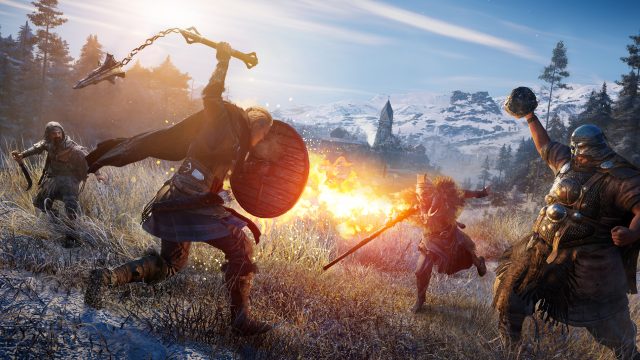
In a subsequent cutscene, a grateful Oswald invited me to his imminent wedding to Dane warrior, Valdis, at a separate place called Elmenham. It was a simple journey by horse, and upon arriving, I bore witness to the ceremony, officially uniting East Anglia with the Danes. As a result, Eivor and his fellow Vikings started enjoying a lively reception, at which point I could try out some of the very amusing minigames on offer in Assassin’s Creed Valhalla. This began with me betting 80 silver against a fellow Viking named Broder that I could drink him under the table. Thus began a minigame that involved pressing the A Button in time with a descending circle, occasionally having to flick the left stick in a certain direction to maintain balance, an event I easily prevailed in, at the cost of the screen blurring and the controls becoming sluggish, leaving Eivor having to awkwardly stumble to the next party distraction; Drunken archery! This is not a stunt one should try at home, but was nonetheless a simple matter of hitting a certain amount of pots using my bow within a 20-second time limit, this time hosted by Broder’s twin brother, Brothir. I once again succeeded, which left me with the unenviable task of pulling a drunken Finnr off of a roof. As you do.
Oh, and remember how I said that a certain humourous encounter took place later in my demo? Well, this occurred once I was approached by Broder, upon depositing Finnr back on safe ground, who expressed admiration of Eivor’s battle skills and strength of character. That interest wasn’t purely platonic either, with Broder eventually coming out and admitting that he wanted sex. As tempted as I was to reflect my own heterosexuality in Eivor’s character, I simply had to see where this encounter led, so I agreed to the proposal. Broder was clearly quite satisfied afterward, but there was one problem– Even in the real world, I wasn’t paying attention to which twin Broder was. Thus, when I was suddenly greeted with a branching dialogue choice, I mis-identified Broder as his brother, Brothir, something that Broder was naturally quite upset about. That said, I must admit that I had a good chuckle at my own surprisingly immersive, devil-may-care lovemaking habits as a bi-curious male Eivor, feeling just a little bit like a Viking player, if such a thing indeed existed among Danes.
The party did eventually become a little more tense once it was crashed by a vengeful Rued however, who broke out of his confinement while awaiting trial! After Rued then challenges Oswald for the right to rule East Anglia, I was given the choice to intervene or allow Oswald to fight his own battle, at which point, I chose to let Oswald fight. To my pleasant surprise, Oswald successfully over-powered and defeated Rued as well, exiling him from the kingdom, but also sparing his life. It was very interesting to see how my former dialogue choices noticeably altered both the bond between Eivor and Oswald, as well as the fate of Rued. Because I’d displayed so much faith in Oswald, he doubled down on an alliance with Eivor’s clan, no doubt promising yet more allies during the difficult battles ahead, later in the game’s story.
At this point however, my demo’s story preview ended. Because I’d spent so much time dying and retrying battles, I only had a short time to wander around the world and indulge in side tasks as well. I chose to spend some of that time sailing around in a longboat, once again taking advantage of the cinematic camera to take in some of the lovely visuals, before taking on one particular side quest from a dying man. This man wanted to fall in battle, while teaching his son the ways of his spear. The man proved to be a surprisingly difficult opponent too, felling me several times, which, somehow, is not what I was supposed to accomplish. Apparently, I was supposed to traumatize the boy by murdering his ailing father in front of him, rather than let the boy’s father show him how to use a spear by felling a Viking warrior, which feels a little head-scratching. Regardless, despite his outstanding range advantage, especially with my Eivor only being able to wield short-range weapons that crucially required me to wait until the spearman was staggered before I could strike back (a lesson I only learned after several embarrassing deaths), I eventually prevailed, earning a Skill Point for my efforts.
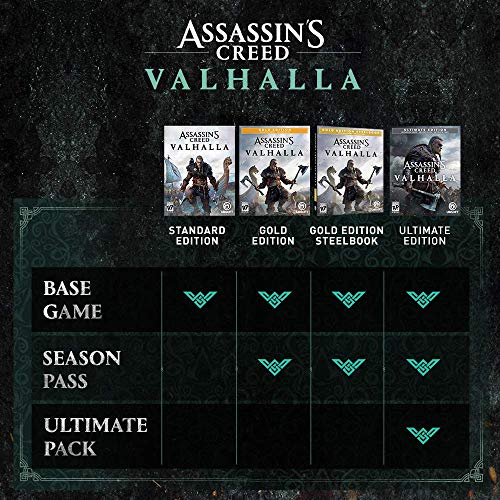
At this point, my preview session ended. merely giving me the chance to talk to a few more NPC’s before I had to stop gameplay. Still, as much as it was initially daunting, punishing and took a good bit of practice, I did eventually find myself adjusting to the open-ended, yet accessible gameplay foundation of Assassin’s Creed Valhalla. The game aims to reduce the bloat and busy work that was claimed to be a problem in the previous Assassin’s Creed Odyssey, and that certainly appears to have been swapped for more intensity, and more challenge in Assassin’s Creed Valhalla. Obviously, a few hours with a preview build can only give me a small taste of what’s sure to be a massive, sprawling game, even as it aims to trim the fat from Assassin’s Creed Odyssey, but in finally getting a glimpse at just how far Assassin’s Creed has come since the days of the Xbox 360 and PS3, I was left extra eager to catch up on what I’ve missed.
The question remains then, does Assassin’s Creed Valhalla seem like it’s going to be worth purchasing later this year, for rookies or veterans? Well, there’s no denying that series veterans who have played through every Assassin’s Creed game to date will have the most efficient time with it, especially considering the punishing nature of the combat. In terms of fundamental play mechanics however, even rookies can eventually get a handle on how to play, after a few hours or so. Assassin’s Creed Valhalla may be large and imposing to the uninitiated at first, but it never feels complicated or inaccessible, even to an inexperienced player. You’ll need some patience if you’re among the beginners, but if you plan to buy Assassin’s Creed Valhalla to go with your brand new PS5 or Xbox Series X, it looks like you’ll be able to enjoy it just fine, once you get over that initial learning curve. Even on current-gen PS4/Xbox One specs, Assassin’s Creed Valhalla is a well-produced, epic and visually striking experience, though my demo’s rather lengthy load times could be the price of sticking with current console hardware, should you not be ready to invest in a next-gen console or high-end PC.
Either way, Assassin’s Creed Valhalla looks to continue the series’ recent successes, providing a leaner, more engaging experience than Assassin’s Creed Odyssey sometimes did. It certainly won’t convert you if you already dislike the franchise’s recent gameplay path, but I found myself enjoying what I played, and eager to see the rest of the experience later this year, despite having to wrap my head around a lot of new Assassin’s Creed gameplay mechanics since the previous console generation. Once I did that though, I became a halfway decent Viking, right down to crushing ale and mixing up the men I’d laid with.
Assassin’s Creed Valhalla will release on November 10th, 2020, for Xbox One, Xbox Series X, PS4, Stadia, and PC via uPlay and the Epic Games Store. The PS5 version of Assassin’s Creed Valhalla will launch alongside its console in Holiday 2020

